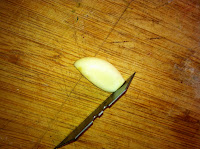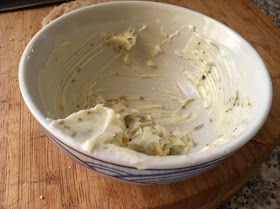Last year, I brined the turkey for the first time, and I must say, I was very impressed with it! So, I decided to continue the tradition this year. Brineing sounds complicated, but essentially, you just boil water, add some salt and other spices of your choosing, and then you soak the bird overnight.
The brine solution seeps deep into the muscles of the bird, allowing the flavor to fully penetrate all the way to the bone. The salt also massages the meat and makes it soft and succulent.
I still put a rub on the outer skin of the turkey, to make sure the skin was very crispy and delicious.
When we were younger, my mom would stuff the cavity of the bird with stuffing. But I find that the stuffing absorbs a lot of the liquid, and tends to dry the bird out, which is what I want to avoid. Instead, I stuff the cavity with cut of vegetables-Fennel, onion, carrots, celery, some fresh herbs like parsley, sage, rosemary and thyme (like the Simon and Garfunkel song, "Scarborough Fair"). I also got a trick from Jamie Oliver. He takes a lemon, boils it whole in water for a few minutes, pokes it a few times with a knife and them stuffs it "straight up the jacksie" of the turkey. I found this was really crucial-as the turkey cooked, the heat forced all the lemon juice out. As it released, the steam helped cook the bird from the inside and released a delicious flavor to the inside of the bird.
I also braised the turkey with a little garlic butter and homemade chicken stock. I basted the bird about once every hour,
The brine and the rub mixture I got from Michael Chiarello, who I think is a genius! You can find his recipe here.
You need to let the brine come down to room temperature before you pour it on the turkey. You can chuck a bag of ice in it, or make it in advance and let it cool to room temperature naturally. I let it cool naturally.
Timing is key on this. You want to brine the turkey for about 12 hours, no more or less. If you brine less than 12 hours, the flavor won't work itself into the meat. If you brine for more than 12 hours, the meat will get too salty and dry and won't taste good.
Have a nice big ice chest to put the turkey into. The turkey also needs to brine in a cool place, so I will put it into the garage, or leave it out on the porch overnight.
Make sure to remove it from the brine 1 hour before you begin to roast it. This way, the meat will come up to temperature and you will have a more even cooking process.
For the brine:
6 quarts water
2 cups kosher salt
½ cup light brown sugar
2 tablespoons whole black peppercorns
8 bay leaves
4 tbsp juniper berries (optional)
1 quart ice
6 quarts water
2 cups kosher salt
½ cup light brown sugar
2 tablespoons whole black peppercorns
8 bay leaves
4 tbsp juniper berries (optional)
1 quart ice
2 pieces dried mikan (tangerine) peel (optional)
For the turkey:
½ cup extra-virgin olive oil, divided
½ cup spice rub (recipe below)
8 sprigs fresh rosemary
1 lemons, whole
4 large carrots, halved lengthwise
½ cup extra-virgin olive oil, divided
½ cup spice rub (recipe below)
8 sprigs fresh rosemary
1 lemons, whole
4 large carrots, halved lengthwise
2 carrots, chopped rough
8 celery stalks, chopped rough
8 celery stalks, chopped rough
1 fennel plant, bulb and stalks, chopped rough
2 onions, quartered
For
the Fennel Spice Rub:
1 cup fennel seeds
3 tablespoons coriander seeds
2 tablespoons white peppercorns
3 tablespoons kosher salt
A few cloves of garlic
1/2 stick of butter
For the Braising Stock
Homemade chicken stock
For Sage Gravy
Freshly cut Sage
Cornstarch
For the brine
The day before Thanksgiving:
Combine all brine ingredients (except for ice) in a stockpot, and bring to a boil. Stir to dissolve solids, then remove from heat. Cool till room temperature. Refrigerate until thoroughly chilled. Alternatively, if you want to make the temperature come down quickly, chuck a bag of ice in it.
 Remove giblets from turkey. You can either save them for making stock or discard. Wash the whole bird with fresh water, inside and out. Pat dry with a few paper towels. Place the bird in a large cooler.
Remove giblets from turkey. You can either save them for making stock or discard. Wash the whole bird with fresh water, inside and out. Pat dry with a few paper towels. Place the bird in a large cooler.
Next, add the cooled brine to the cooler, as to the right.
Place the cooler outside in your garage overnight for 12 hours. I usually put the turkey in the brine around 10pm on Wednesday.
Thanksgiving Morning:
Remove the turkey from the brine after 12 hours (10am for me). Place in a sink and let the turkey come to room temperature for 2 hours (12pm). Discard the brine and make sure to clean out the cooler!
In the meantime, chop your vegetables prepare your and spice rub.
For the vegetables:
Cut and prep the vegetables.
Boil a small pan of water and place the lemon inside of it. Boil the lemon for several minutes. Take a knife and make several incisions in the lemon (the knife should easily penetrate the lemon). Stick the lemon in the jacksie (backend) of the turkey.
Take the carrots that have been cut in half and arrange on the tray you are going to cook the bird in. This will serve as the rack for the turkey. I prefer a deeper tray, and there will be much liquid you add.
For the Spice Rub:
Take a heavy cast iron skillet and heat. Over medium heat, add the fennel seeds, coriander seeds and white peppercorns. Toast them for a few minutes, until their flavor and aroma is released. Toss frequently, so that the seeds don't burn. Remove from heat and let cool.
Once cool, grind in a spice grinder. If you grind them when they are still warm, they will stick to the blades.
Prep the Turkey
At 11:30, preheat the oven.
Place the turkey on the rack. With one hand, pull the skin of the turkey back around the breast. With your other hand, take a chopstick and separate the skin from the breast. The skin will now look flappy. Take some of the fennel spice rub, stick you hand between the skin and the breast and rub it into both breasts of the turkey with the rub.
Next, take some good quality olive oil and generously pour it all over the turkey. With your hands, massage the oil into all the folds of the turkey, making sure to get the wings, the drumsticks and the bottom of the turkey.
 Take the remainder of the fennel rub and rub it all over the turkey.
Take the remainder of the fennel rub and rub it all over the turkey.Once the over comes up to temperature, place the bird in the oven (around 12:00).
Continue cooking the turkey, basting every hour with the garlic butter and braising stock (see below), until done. (around 5-6 hours for my bird). If you find the top of the bird is getting overcooked, place some aluminum foil on it.
For the Garlic Butter

Slice several gloves of garlic with a razor blade, so they are paper thin.
Take a small saucepan and add half a stick of butter. Melt the butter and add the garlic. Simmer for a few minutes on low heat to let the flavor develop. Remove from heat.
For the Braising Stock
Take a cup of homemade chicken stock and bring to a boil. Reduce heat to low and cook for a few minutes to help the flavor release. Remove from heat.
When the bird comes out, there will be a great deal of liquid in the pan (partially from the chicken stock, but also the bird will sweat out a lot of water). Mine came out like this:
Scoop out most of the liquid from the pan and place in a small saucepan. You can use this as the base for your gravy.
For the Sage Gravy
Heat the saucepan with the turkey and chicken stock in it (see above). Whisk in cornstarch, a little bit at a time, until the stock thickens to a gravy. Once the gravy has the thickness you desire, continue whisking (but not adding more cornstarch), until all the cornstarch is dissolved and it looses its raw taste. You really don't need to add any salt, because alot of the salt sweated out of the brine mixture and the fennel rub. Add freshly cut sage (or even rosemary) to give it some flavor. Strain the gravy into a gravy boat.















































